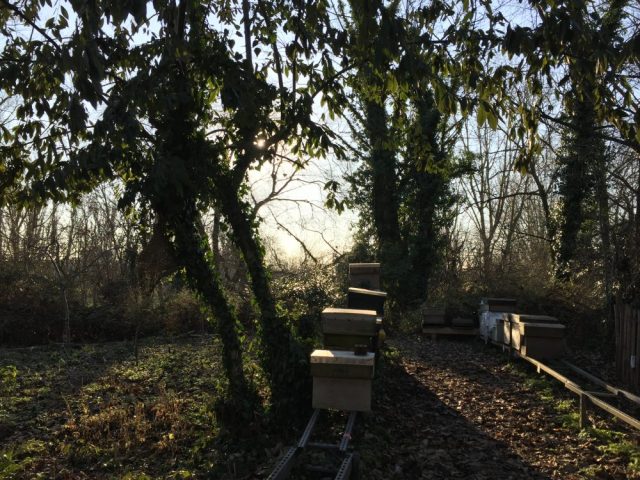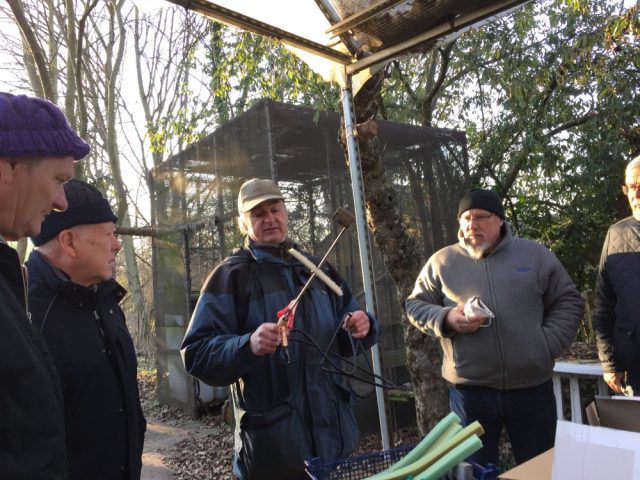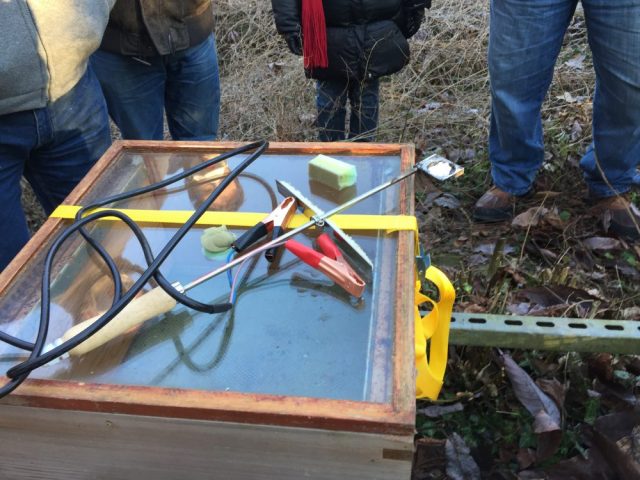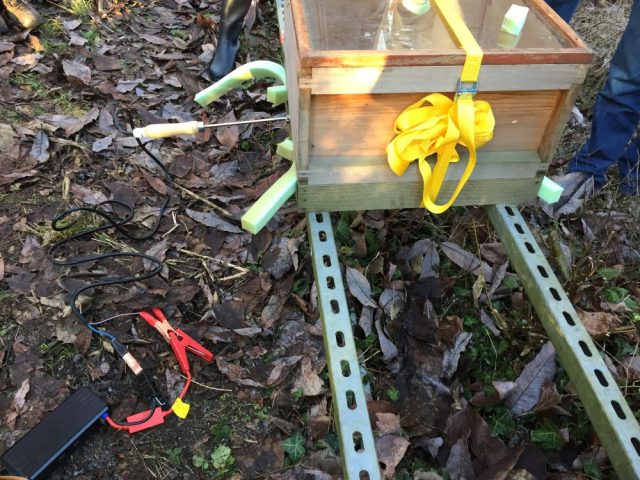It was a beautifully sunny but chilly day yesterday for a demonstration by Tom of oxalic acid sublimation. Amazingly some of our bees were still flying even at temperatures of under 10°C (50°F). The snowdrop shoots haven’t come on much further.
Inside our nuc the bees were still active but clustered more tightly than before. I smeared some extra fondant on top of a few of the frames. They have fondant left in the side feeder still, but I thought it would be nice for them to have some nearer the cluster.
In our bigger hive the ladies remain up in their fondant and pollen bags, but they have plenty of the sweet stuff left still. Nibble nibble.
A good number of us had gathered to see Tom demonstrate how oxalic acid sublimation (vaporisation) works. His subliminator cost around £35 (see Thorne’s Vapmite one) and the car battery charge around £35 too, so initial equipment costs are about £70. He did say this was a cheap subliminator and it’s starting to fall apart, there is a more expensive version available for around £100 which would probably last longer. You will also need oxalic acid in the approved form of Api-Bioxal, which conveniently contains extra sugar that identifies it as Api-Bioxal and makes the subliminator tray extra-sticky.
As the apiary bees were already treated by the drizzle method before Christmas, this was only a demonstration on an empty hive. The hive had a glass crown board so we could see the effects of the gas in a confined space. We were all wearing masks, this is very important as the oxalic fumes are dangerous to humans.
Tom began by putting foam in at the entrance, this helps keep the fumes inside the hive. He left the subliminator in for 3 mins 20 seconds attached to the battery to heat up the oxalic acid, then another 3 mins without the battery to cool down. You can then remove the subliminator and leave the hive sealed up with foam for 5-10 mins after that, before removing the foam (please read the official instructions before doing it yourself rather than relying on these timings, in case I am mis-remembering anything!).
As the oxalic acid vaporises, the vapour fills the hive, coating the bees and hive surfaces with a very thin layer of oxalic acid crystals. The bees cope well with these crystals, but they have a deadly effect on varroa mites.
The advantages of sublimation are:
- You don’t need to open up the hive, which breaks propolis seals and can potentially disturb the bees.
- You can carry out repeated treatments, whereas the drizzle should only be carried out once annually.
- Research carried out by the University of Sussex Laboratory of Apiculture and Social Insects suggests that, compared to spraying or dribbling, sublimation has a higher varroa kill rate (see Integrated control of Varroa mites on the LASI website).
The disadvantages of sublimation are:
- The extra costs of the subliminator and battery equipment.
- Oxalic acid is toxic to humans, so you have to be very careful when handling it; including wearing gloves and a mask to avoid breathing in the fumes.
The instructions on Thorne’s website have some interesting details – they say the air temperature should not be below +4°C and the last cleansing flight should not date back more than four weeks. This is probably not something we need to worry about in London, but further north daytime temperatures might drop lower than 4°C. The LASI guidelines recommend applying oxalic at outside temperatures of 4-16°C.
Useful links:
- How to Apply Oxalic Acid Via Sublimation to Control Varroa – LASI guidelines
- How to Apply Oxalic Acid to Honey Bee Colonies via Sublimation – LASI video
- The Best Way To Kill Varroa With Oxalic Acid – Bee Culture article by Francis L.W. Ratnieks, Luciano Scandian, Hasan Al Toufailia, February 2016








Thanks for the details. It would be a good idea to test your dexterity and give you confidence if you could try it on an empty hive for the first time. I like the idea of this method and your link for Vapmite is very interesting as the only ones I have seen ran into hundreds of euros. My problem is that I have read that it is only efficient when there is no brood as it only kills the phoretic mites and I do not think that our bees are ever without brood. Thus saying, as far as I have read almost all the treatments kill only the phoretic mites leaving the rest safe inside the larvae. I like the idea of the one day treatment as we had to treat our bees with Apilifevar for five weeks starting in September to get them all below an acceptable level. Amelia
LikeLike
It is certainly more efficient when there’s no brood, but at least in winter brood levels will be lower and the way I look at it is killing the phoretic mites is better than nothing. It helps get the levels down again after the September treatment. I suspect our hives are not totally broodless over winter either.
LikeLiked by 1 person
Myself and others in Lampeter Beekeepers’ Association have used oxalic sublimation for the first time this year, some in December and other this month. We have all seen a high mite drop. All four of my hives have dropped 80-100 mites every day for the last 6 days since the initial treatment, despite all having been treated using MAQS at end of last season. I would certainly recommend paying extra for the more expensive vaporiser tool – we bought the tool, battery charger and tubs of crystals as an Association, hiring it out to members for a small charge to recoup costs. One of our members has been using sublimation in September – three treatments, each five days apart, for every hive – for a few years. Her view is that it is more effective than any thymol treatment she’s used in the past and oxalic sublimaion is now her only varroa treatment.
LikeLike
Thanks Philippa. Glad to hear you nuked so many mites! Great that your association is hiring out the vaporiser. I took a look at your blog and enjoyed your post about vaporising 🙂
LikeLike
Brilliant article !!
Clare xx
________________________________
LikeLike
Thanks Clare 🙂
LikeLike
Yes, great article. It is interesting how the oxalic acid gas hurts the mites and not the bees. Dangerous to humans yet bees are not affected.
LikeLike
Yes, and we still don’t know exactly how the acid kills the mites. There are theories but nothing proven. The bees are affected by the acid if they ingest it in liquid form and yet the fumes seem to be ok. A reminder of how different their internal systems are to ours.
LikeLike
Pingback: Oxalic acid sublimation demo | How To Raise Bees
Pingback: Oxalic acid sublimation demo | Raising Honey Bees